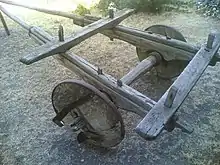Kankalis
The Kankalis (康曷利;[1] pinyin: Kānghélì; Middle Chinese (ZS): /kʰɑŋ-ɦɑt̚-liɪH/ or 康里 pinyin: Kānglĭ < MC-ZS: /kʰɑŋ-lɨX/;[2] Middle Turkic: قنكلى Kaγnï or قنكلى Kaŋlï, also spelled Qanglı; Kanly, Kangly, or Qangli) were a Turkic people of Eurasia who lived during the time of the Mongol Empire and Yuan dynasty.
Origins
They may be related to the Kipchaks or Pechenegs. Or they may have been a branch of the Tujue people who were conquered by the Tang dynasty of China.
Historical references

Kara-Khanid lexicographer Mahmud al-Kashgari mentioned a Kipchak chief surnamed Qanglı and simply glossed Qanglı as "a wagon for carrying load".[4] Supposedly, they might be identified as[5] or closely related to Kipchaks;[6] or formed part of the Pechenegs.[7]
Byzantine Emperor Konstantinos Porphyrogennetos (aka, Constantine VII) mentions three Pecheneg tribes collectively known as Kangar in his De Administrando Imperio. Kangar is associated with the Kang territory and probably with the Kangaris people and the city of Kangu Tarban, mentioned in the Kul Tigin inscription of the Orkhon Turkic peoples.[8]
Still, the relationship between the Kanglys, the Kangars, and the Kangaris / Kengeres (allies of the Eastern Turkic Khaganate against the Western Turkic Khaganate), is still unclear.
They may have even been a branch of the Tujue people who were conquered by the Tang dynasty of China.
The Tang dynasty historical text Tang Huiyao apparently distinguished the Kangheli from the Kang nation, also known as Kangju nation.[9]
History
After the fall of the Pecheneg Khanate in the early 10th century, the role of the Kankalis became prominent. Different Pontic Steppe's Turkic nomadic peoples , who might have been separate and distinct earlier, would eventually become assimilated into each other by the 13th century. The eastern grouping of Cumania was indeed known as Qanglı (Latin: Cangle).[10]
Many Kankali warriors joined the Khwarezmid Empire in the 11th century. In 1175 some of them lived north of Lake Balkhash and transferred their allegiance from the Kara Kitai to the Jin dynasty.[11]
They were conquered by Genghis Khan's armies during the Mongol conquest of Central Asia in 1219-1223. All Kankalis in Bukhara who were taller than a wheel, were slain by the Mongols. Jochi subdued remnants who still lived in the land of the Kyrghyz and Kipchak steppes in 1225. Khwarizmi Kankali remnants submitted to Great Khan Ögedei after a long resistance under Jalal ad-Din Mingburnu against his general Chormaqan and governor Chin-temur. After the Mongol conquest, the remaining Kankalis were absorbed into other Turks and Mongols. Some of them who served in the Yuan Dynasty became Kharchins.
There are Kankali clans among the Kazakhs, the Uzbeks, the Kyrgyz, Bashkirs, the Nogais and the Karakalpaks.
People
- Hama (Yuan dynasty), an official of the Yuan dynasty of China
References
Citations
- Tang Huiyao, Ch. 72 "康曷利馬。印宅。" Kangheli's horses; tamga [resembles] [character] 宅
- History of Yuan, vol. 205 txt "哈麻,字士廉,康里人" "Hama, courtesy name Shilian, a man of the Kangli (tribe)"
- Hasan Eren (1999). Türk dilinin etimolojik sözlüğü. p. 200.
- Golden, Peter B. (1992). An Introduction to the History of the Turkic People. Otto Harrassowitz, Wiesbaden. p. 272-273.
- The Cambridge History of Early Inner Asia, Volume 1, Denis Sinor, pg 272
- Thomas T. Allsen, "Prelude to the western campaigns: Mongol military operations in the Volga- Ural region, 1217- 1237", Architum Eurasiae Medii Aevi, pp. 5-24
- Golden, Peter B. (1992). An Introduction to the History of the Turkic People. Otto Harrassowitz, Wiesbaden. p. 272-273.
- The Cambridge History of Early Inner Asia, Volume 1, Denis Sinor, pg 272
- Tang Huiyao, Ch. 72, "康國馬。康居國也。[...]"
- Golden, Peter B. (1992). An Introduction to the History of the Turkic People. Otto Harrassowitz, Wiesbaden. p. 272.
- Michael Biran, Empire of the Kara Kitai, page 57
Sources
- Rashiduddin Fazlullah's Jamiʻuʼt-tawarikh by Rashīd al-Dīn Ṭabīb, translated and edited by Wheeler McIntosh Thackston.
- The Mongols - A History by Jeremiah Curtin.